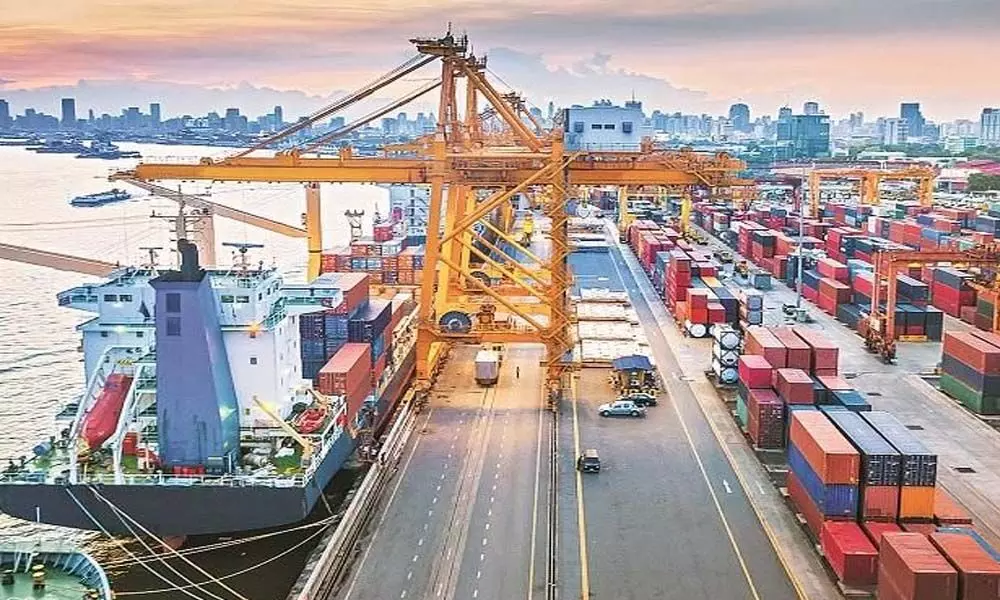India needs strong supply chain infra to reap benefits of reviving world economy
Exports have become a bright spot in the Indian economy at a time when positive indicators are hard to find. It is now for govt to provide more infra support to boost Indian exports
image for illustrative purpose

Exports have become a bright spot in the Indian economy at a time when positive indicators are hard to find. The April-June quarter (2020-21) has seen them rise to a record level of $95 billion, an increase of 17 per cent over the same period in 2019. This indeed remarkable given that the world economy is struggling to get back to normalcy. One of the positives for exporters is that the US economy is reviving in a robust way owing to widespread vaccinations and the opening up of normal activities in most parts of that country. And the US is India's leading trading partner after the European Union.
A review of the biggest items in the country's export basket reveals that a major spurt during this quarter has been in electronics goods. This is clearly one of the fall-outs of the production linked incentive scheme that was introduced in the electronics sector about five years ago. It led to the mushrooming of electronics units especially mobile phone and LED manufacturing plants. Handsets which had earlier been largely imported by the major brands then began to find it more profitable to set up units here and supply to the huge growing Indian market. In fact, the growth in output of both LED and mobile phones has risen by a steep 46 and 45 per cent respectively over the period from 2013-14 to 2018-19. This in turn has evidently pushed up exports of electronic goods over the past few years.
This is part of the overall buoyancy in engineering goods exports which have risen by about 15 per cent over the period from January to June compared to two years. The reason once again is the rise in demand from major markets like the US and the European Union, according to engineering export organizations. But there is another area that has shown rapid growth over the past few years and is likely to form an increasingly large share of the export basket in future. And that is agricultural and allied exports. These rose by 17.34 per cent in 2020-21 to 41.25 billion dollars and this momentum is expected to continue in the current fiscal as well. Excluding marine and plantation exports, the rise is even higher at 28 per cent over this period.
One of the reasons for this spurt in agro exports is the fact that India is now a surplus producer of both wheat and rice. It has sufficient stocks to meet the needs of the public distribution system, the additional needs of new food welfare schemes during the pandemic and also for exports. Rice and wheat stocks in the central pool are reported to have reached 77 million tonnes at the beginning of the current fiscal, vastly higher than the minimum level stipulated originally for food security at 21 million tonnes. In other words, there is ample available for export on a sustained basis to other countries.
It is specifically in rice, however, that India has become a leading exporter in recent years both for basmati and non-basmati rice. It is currently rated as the top exporter in the world followed by Thailand. The extent of rise in exports of this cereal has been startling even during the pandemic. Rice exports grew from 9.5 million tonnes in 2019-20 to a record 17.7 million tonnes in 2020-21, an increase of 86 per cent.
What is also interesting is that apparently the plan to revive agro and horticultural exports by a district level seems to be yielding results. Commerce Ministry officials claim that export of fresh vegetables and mangoes from Varanasi and the unusual black rice from Chandauli have also taken place for the first time.
With this kind of resurgence in exports especially in the agricultural sector, it is time for policymakers to pay greater attention to this segment of the economy. While the country is not likely to become an export-led economy in the short run, promoting export industries can definitely shore up growth in many key segments. As far as agricultural exports are concerned, the problem has always been that sustained annual orders have been difficult to maintain because of the need to meet domestic consumption needs. This hurdle now seems to have been overcome at least in cereals exports where there is more than enough availability within the country to ensure that orders can be met regularly over a period of several years. The other problematic issue for increasing agro exports is the lack of adequate infrastructure to maintain the supply chain. For instance, there has always been a shortage of warehouses and cold chain storage facilities for agricultural and horticultural products. It is in recognition of these lacuna that several new schemes were announced in the last budget. One can only hope that these are implemented and brought into operation as soon as possible.
It is surely to the credit of the exporting community that progress has been made in this area despite the disruption of the pandemic and regional lockdowns during the first and second Covid waves. It is now for the government to provide more infrastructural support to exporters to enable them to meet their commitments and reap the benefits of a reviving world economy.

